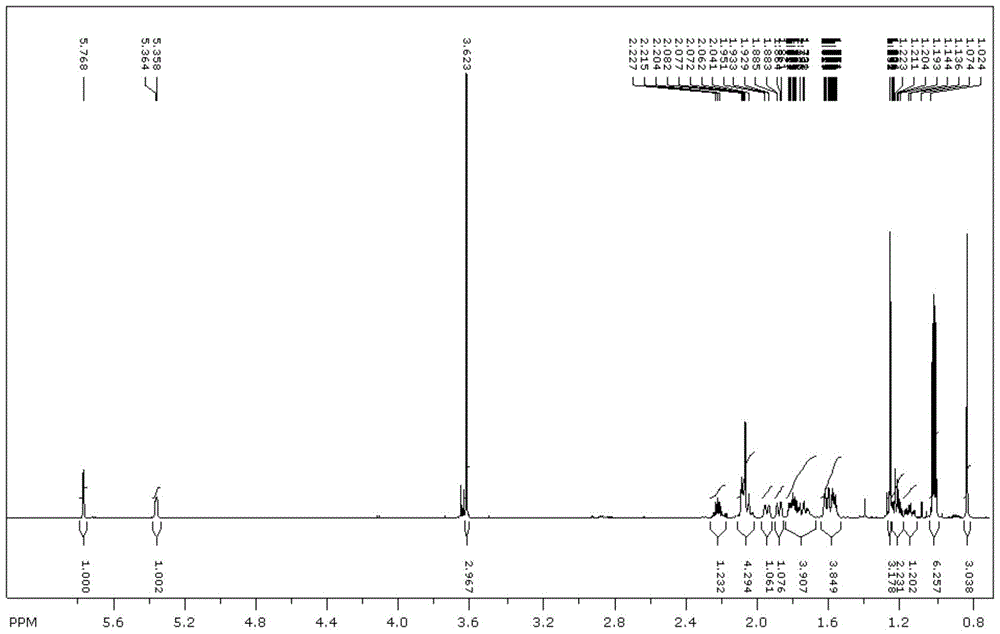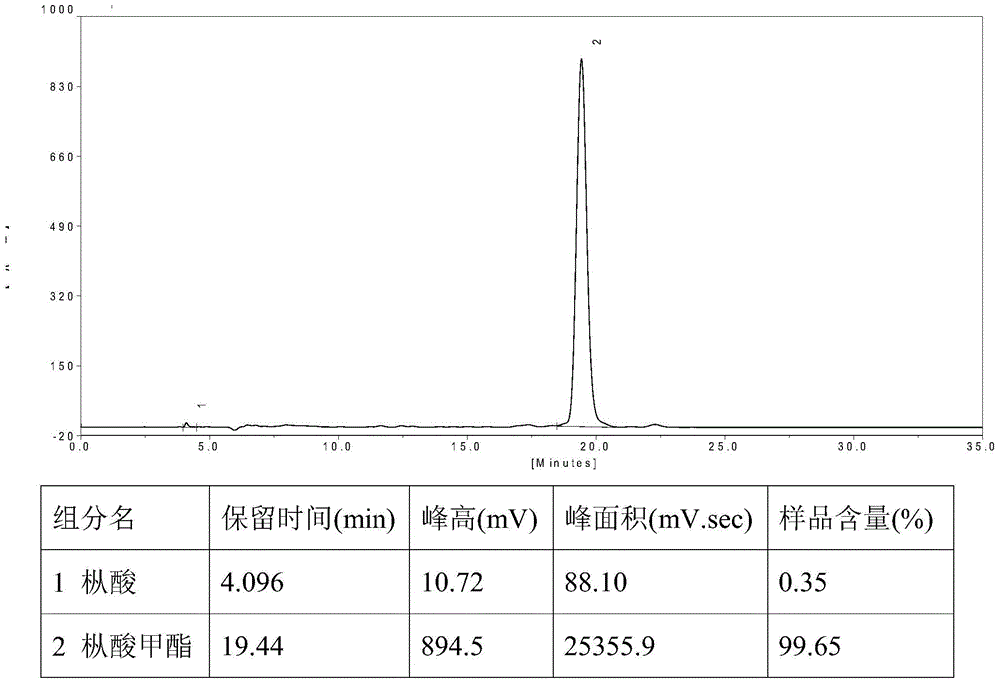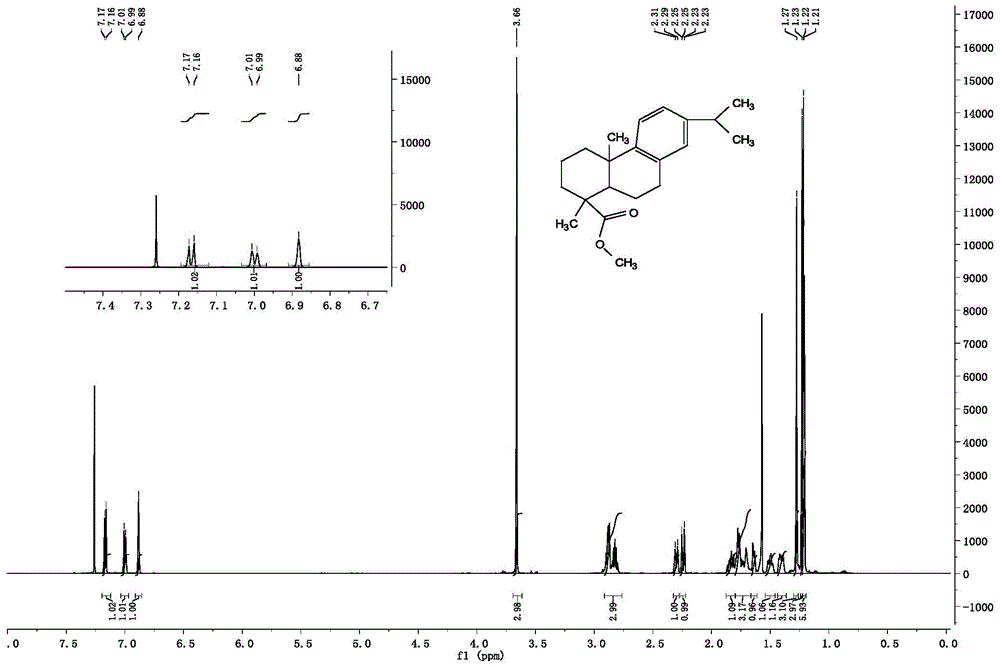Methyl esterification method of low-toxicity rosin-resin acid
A technology of rosin resin acid and rosin resin, which is applied in chemical instruments and methods, carboxylate preparation, organic chemistry, etc., can solve the problems of low reaction yield, high toxicity, and few side reactions, and achieve high yield and low toxicity. The effect of low cost and easy availability of raw materials
- Summary
- Abstract
- Description
- Claims
- Application Information
AI Technical Summary
Problems solved by technology
Method used
Image
Examples
Embodiment 1
[0023] Synthesis of methyl abietic acid:
[0024] Taking abietic acid as raw material, its reaction formula is as follows:
[0025]
[0026] In the reaction formula, I is abietic acid, II represents dimethyl carbonate, and III is the product methyl abietic acid. In the 250mL three-neck flask equipped with stirrer, thermometer and reflux condenser, add 30mL organic solvent DMF, then add abietic acid (0.05mol, 15.0g) and methylation reagent dimethyl carbonate C 3 h 6 o 3 (0.5mol, 45.0g), alkali catalyst lithium hydroxide LiOH·H 2 O (0.1mol, 4.2g), make abietic acid, dimethyl carbonate, lithium hydroxide dissolve in DMF, under the protection of nitrogen, in 100 ℃ of oil baths, be heated to stable reflux, namely when the number of reflux drops in the three-necked bottle is 1 to 2 drops / second is stable, and the stable reflux temperature is 93°C. The progress of the reaction was tracked by thin-layer chromatography every 1 hour until it was detected that there was no reacti...
Embodiment 2
[0034] Synthesis of methyl abietic acid:
[0035] Taking abietic acid as raw material, its reaction formula is as follows:
[0036]
[0037] In the reaction formula, I is abietic acid, II represents dimethyl carbonate, and III is the product methyl abietic acid.
[0038] In the 250mL three-neck flask equipped with stirrer, thermometer and reflux condenser, add 30mL organic solvent DMF, then add abietic acid (0.05mol, 15.0g) and methylation reagent dimethyl carbonate C 3 h 6 o 3 (0.75mol, 67.5g), alkali catalyst potassium carbonate K 2 CO 3 (0.1 mol, 13.8 g). Dissolve abietic acid, dimethyl carbonate, and potassium carbonate in DMF, and heat it in an oil bath at 118°C under the protection of nitrogen to a stable reflux, that is, when the number of reflux drops in the three-necked bottle is 1 to 2 drops / second, it is stable. The stable reflux temperature, ie, the reflux temperature, was 110°C. The progress of the reaction was tracked by thin-layer chromatography every ...
Embodiment 3
[0041] Synthesis of methyl abietic acid:
[0042] Taking abietic acid as raw material, its reaction formula is as follows:
[0043]
[0044] In the reaction formula, I is abietic acid, II is dimethyl carbonate, and III is the product methyl abietic acid.
[0045] In a 250mL three-neck flask equipped with a stirrer, a thermometer and a reflux condenser, add 100mL of organic solvent acetone, then add abietic acid (0.05mol, 15.0g) and methyl esterifying reagent dimethyl carbonate C 3 H 6 O 3 (1.5mol, 135g), alkali catalyst potassium carbonate K 2 CO 3 (0.1 mol, 13.8 g). Abietic acid, dimethyl carbonate and potassium carbonate were dissolved in acetone, and heated to a stable reflux in an oil bath at 75°C under nitrogen protection, that is, when the number of reflux drops in the three-necked flask was 1 to 2 drops / second, it was stable. The stable reflux temperature, that is, the reflux temperature, was 68°C. The progress of the reaction was tracked by thin-layer chromatog...
PUM
 Login to View More
Login to View More Abstract
Description
Claims
Application Information
 Login to View More
Login to View More - R&D
- Intellectual Property
- Life Sciences
- Materials
- Tech Scout
- Unparalleled Data Quality
- Higher Quality Content
- 60% Fewer Hallucinations
Browse by: Latest US Patents, China's latest patents, Technical Efficacy Thesaurus, Application Domain, Technology Topic, Popular Technical Reports.
© 2025 PatSnap. All rights reserved.Legal|Privacy policy|Modern Slavery Act Transparency Statement|Sitemap|About US| Contact US: help@patsnap.com



